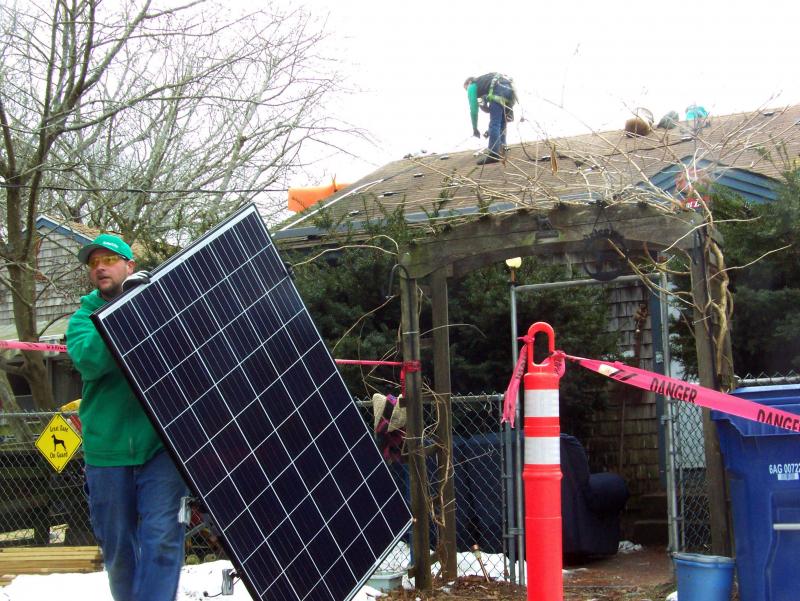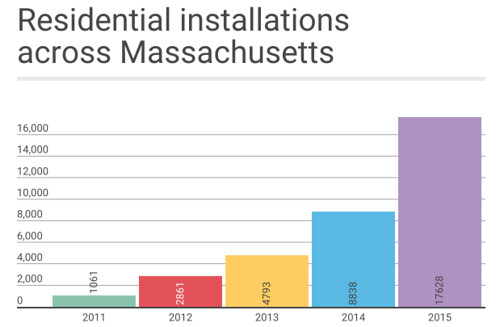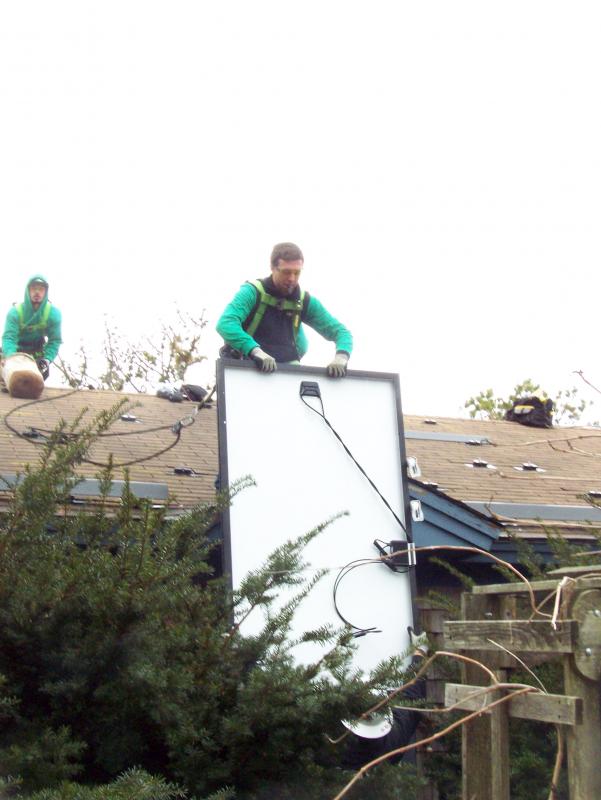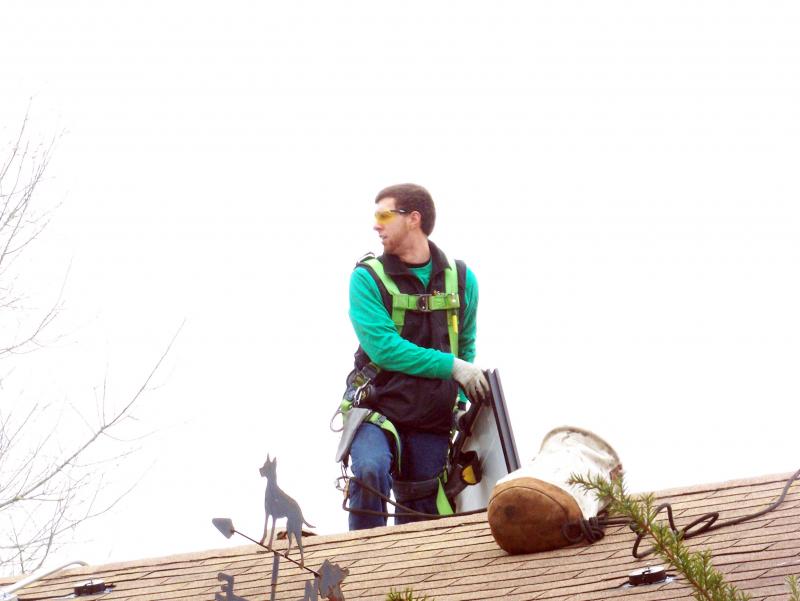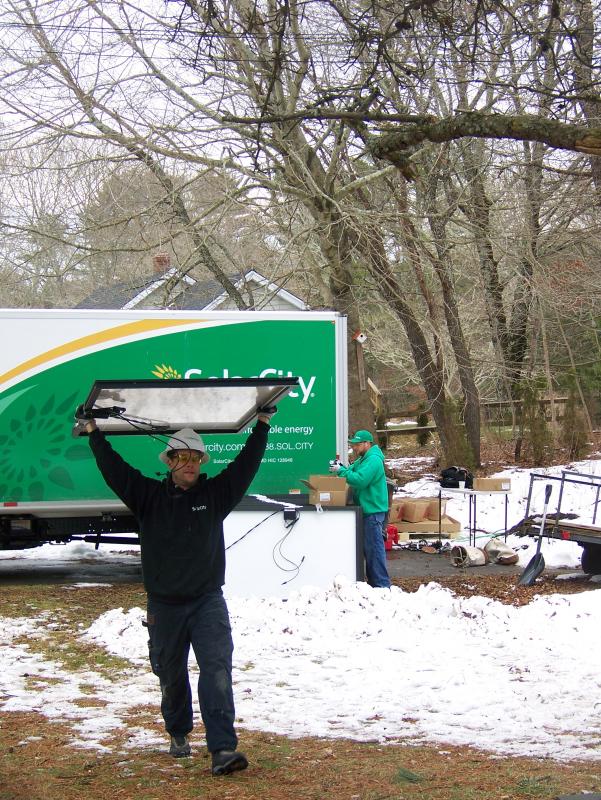Tri-town sees surge in residential solar arrays
When it comes to solar energy, more and more tri-town households are going green, both for the ecological and economic benefits.
Marion, Mattapoisett and Rochester saw a big uptick in residential rooftop solar systems from 2013 to 2015, which some have attributed to hefty state and federal incentives, the falling cost of solar panels and the fear that legislators will phase out rebates in the coming years.
In 2013, Marion issued one solar permit for rooftop solar, and last year that figure was 29. Similar spikes were seen in Mattapoisett and Rochester. In 2013, 19 permits were issued in Rochester and six in Mattapoisett. Last year, Rochester OK’d 49 permits while Mattapoisett approved 61.
“Residents, businesses, municipalities and state agencies have created tremendous solar growth across the Commonwealth,” said Massachusetts Department of Energy Resources Commissioner Judith Judson. “With prices coming down and easy access to low interest loans through our Mass Solar Loan program, we expect that individuals and families will continue to invest in clean energy options like solar.”
Andrew Wade, president of My Generation Energy, estimates his company has installed 300 solar systems, both residential and commercial, in the past few years.
Based on Cape Cod, My Generation’s customer base includes a wide swath of southeastern Massachusetts.
Wade said generous state and federal incentives have fueled the residential solar market.
“The state has done their part to incentivize solar. The early adopters have proven it has worked the way people have said it would work,” Wade said. “And that’s why the industry is fairly robust here in Massachusetts.”
Buying solar arrays
Regarding residential solar arrays, there are three options for those wanting to go solar: purchase panels, lease panels or contract with a nearby solar farm to purchase electricity at a reduced rate.
In Marion, the Benson Brook Community Solar Garden came online last year. A relatively new concept in solar energy, community gardens allow residents to purchase electricity at a reduced rate. Wade said gardens make fiscal sense for those whose homes are in shaded areas or don't have consistent access to bright sunlight.
My Generation Energy advocates for homeowners to purchase arrays outright, which is a huge money saver in the long run, according to Wade.
“In my opinion, it’s one of the better investments that can be made if the homeowner properly understands those incentives,” Wade said. “We educate our customers on the difference between leasing and buying.”
Marion resident Bill Saltonstall wholeheartedly agrees.
Saltonstall, a member of the town’s Energy Management Committee, installed solar panels on his Front Street home in 2011.
“I got them because I wanted to save money,” Saltonstall said. “And it all added up. There haven’t been any surprises on the money.”
Saltonstall said the sticker shock of ownership is tempered by the rebates.
He paid approximately $20,000 to install his system, but after a 30 percent federal income tax credit and $1,000 state tax credit the system, it ended up costing $9,162.
There are ongoing benefits as well.
For every megawatt of power generated the state sends Saltonstall a check for approximately $200, known as an SREC. That number used to be closer to $300 when the panels were first installed.
“What’s happened is the incentives have diminished, but so have the cost of the panels,” he said. “Today, I’d get less in incentives but pay less for the system, so they kind of counteract each other.”
With systems such as Saltonstall’s any excess energy generated is turned into credits applied to energy bills.
Saltonstall said there are three or four months per year where his electrical bill is $0. Depending on the month, the bill for the two-story home he shares with his wife has been as low as $16, $4.40 and $3.73.
Marion resident Thomas Friedman was seeing green of a different shade when he purchased solar panels for his Joanne Drive home.
“We’re a very green household to start with, and the long term energy savings was a plus, but more importantly, for our ethos, it was the right thing to do,” Friedman said.
Friedman contracted Vermont-based Grow Solar to install panels on this home. Soon after the installation, Grow Solar was bought by billionaire inventor/investor Elon Musk and folded into his company, SolarCity.
Friedman noted the incentives he received in 2011 were significant and the system paid for itself within four years. More importantly, he said, the system has helped his family reduce their carbon footprint.
“I think different families have different priorities about where they put their money,” Friedman said. “For us, it’s about trying to minimize our footprint.”
Both Saltonstall and Friedman noted that the panels haven’t required any maintenance since being installed.
“They’re up there and they do their magic,” Friedman said.
When the Huguenins built their house on Mattapoisett Neck Road in 2010, the cost of solar panels was prohibitive, said Sharon Huguenin. But she and her husband, Mike, made sure the roof was prime for solar panels, and they ran a conduit from the room to the utility room in case the cost came down.
“We slanted the roof to the perfect degree,” said Sharon.
After discovering that the price of panels had decreased, the couple decided to put their roof to good use and had 40 panels installed by Fairhaven-based Reliable Solar Solutions in August.
They decided to purchase not lease the panels.
“It’s just not advantageous at all,” Sharon said of leasing. “We get the thirty percent federal tax credit, $1,000 state tax credit and the solar resource energy credits.”
Additionally, the panels will be paid for in three and a half years.
Since their solar panels went online in September, the Huguenins have already seen a dramatic reduction in their electricity bill. Their panels are enough to fully power the house over the course of a year, though starting in the fall means they don’t yet have a reserve of energy. Still, the bill was only $20 in November and a little more in December, said Sharon.
“We’re hoping we’ll get back in the credits when it gets a little sunnier,” she said.
Leasing arrays
Some tri-town residents have found leasing the better option because there’s less money spent upfront.
On a cloudy day in January, a SolarCity crew hauled panels from the company’s truck towards the front door of Naida Parker’s Rochester home. The panels were handed off to workers on the roof and installed over a four-hour span.
Parker, a Selectman in town, said she had considered solar for some time, but didn’t have the funds to purchase an array outright. Leasing seemed like an attractive alternative.
While at the Old Rochester Winter Farmers Market, she met Ken Morazes, a SolarCity representative.
“I had heard good things about the company and was interested in saving money, without having to worry about maintenance fees or caring for the panels,” she said.
Consumers who lease solar arrays enter into a long-term contract with a company and pay a small monthly fee. In exchange, the company installs the panels at no cost and maintains them while retaining ownership of the array and the accompanying tax credits and rebates. Homeowners then purchase the electricity produced at a slightly reduced rate.
By leasing, there isn’t money to be spent up front, so homeowners start saving immediately.
Bethany Daniels and her husband, Russ, of Rochester decided to lease panels, which were installed in September.
“The biggest thing was to save money,” said Bethany. “Our electric bill just kind of kept increasing.”
The couple went with leasing their panels because it was a “more affordable option,” plus they were happy to have an environmentally friendly source of electricity.
They are still getting an electric bill each month, but they’re waiting to see how the panels will help them over the long haul.
“It’s still fairly new so we’re going to see how it all plays out.”



